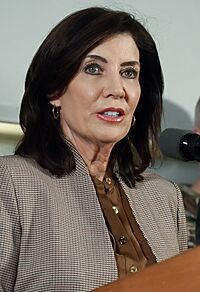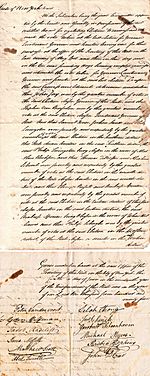Governor of New York facts for kids
The Governor of New York is like the chief leader of the state of New York. This person is in charge of the state's executive branch, which means they make sure state laws are followed. They are also the commander-in-chief of New York's military forces.
The Governor has important jobs, like making sure state laws are put into action. They can also approve or reject (this is called a veto) new laws that the New York Legislature passes. The Governor can also call the legislature together for special meetings and can grant pardons, which means forgiving someone for a crime, except in very serious cases like impeachment or treason. The Governor of New York is currently the highest-paid governor in the United States.
The current Governor is Kathy Hochul. She is a member of the Democratic Party. She became Governor on August 24, 2021, after the previous Governor, Andrew Cuomo, resigned. She was then elected to a full term in 2022.
Quick facts for kids Governor of New York |
|
|---|---|

Standard of the governor of New York
|
|

Seal of the governor of New York
|
|
| Government of New York | |
| Style |
|
| Residence | New York Executive Mansion |
| Term length | Four years, no term limit |
| Constituting instrument | New York Constitution of 1777 |
| Precursor | Royal Governor of the Province of New York |
| Inaugural holder | George Clinton |
| Formation | July 30, 1777 |
| Succession | Line of succession |
| Deputy | Lieutenant Governor of New York |
| Salary | $250,000 (2023) |
Contents
History of New York's Governor
The role of Governor in New York started a long time ago. It began when the British took over New Amsterdam, which was a Dutch settlement. The Governor replaced the Dutch leaders who were called directors or director-generals.
The first New York State Constitution, written in 1777, created the job of Governor. It said that the main power to run the state would be given to a Governor. It also stated that a wise and careful person from the state would be chosen as Governor every three years by a vote. The first Governor of New York was George Clinton, who started his term on July 30, 1777.
How the Governor is Elected
The Governor is chosen by the people of New York in an election every four years. These elections happen in even-numbered years, but not in the same years as presidential elections.
To become Governor, a person must be a citizen of the United States. They also need to have lived in New York for at least five years before the election. There is also an age requirement: no one under the age of thirty can be elected as Governor.
What the Governor Does
The Governor's main job is to make sure state laws are carried out. They have the power to approve or veto (reject) bills that are passed by the New York State Legislature. The Governor can also call the legislature together for special meetings. They can also grant pardons, which means forgiving someone for a crime, unless the crime is treason or involves impeachment.
The Governor is the head of the state's Executive Department. This means they lead many of the state government's agencies and offices. People often refer to the Governor with a special title like His/Her Excellency while they are in office.
Many New York Governors have become very famous. Ten Governors have been chosen to run for U.S. president by a major political party. Four of them, including Theodore Roosevelt and Franklin D. Roosevelt, actually became President. Six New York Governors have also served as Vice President. Additionally, two Governors, John Jay and Charles Evans Hughes, became Chief Justice of the Supreme Court.
Governor's Appointments
The Governor chooses many people to work in their main office, called the Executive Chamber. These choices do not need to be approved by the New York State Senate. Most of the Governor's political helpers report to the secretary to the governor. Most policy advisors report to the director of state operations. This makes the secretary to the governor a very powerful position.
The Governor also names the leaders of different departments, divisions, and offices within the state government. These choices do need to be approved by the state Senate. While many of these appointees might have titles like "commissioner" or "director," only the heads of the main departments are considered part of the state cabinet.
Who Takes Over if the Governor Can't Serve
The Constitution of New York has always had a plan for what happens if the Governor cannot do their job. Since 1777, there has been a lieutenant governor of New York. The lieutenant governor also leads the State Senate.
If the Governor dies, resigns, is impeached, or is away from the state, the lieutenant governor takes over the Governor's duties and powers. Since 1938, the lieutenant governor officially becomes the Governor if the office becomes empty.
If the lieutenant governor's office becomes empty, the temporary president of the state Senate takes on the duties of the lieutenant governor. If both the Governor and Lieutenant Governor cannot serve, the temporary president acts as Governor. If that person also cannot serve, the speaker of the Assembly is next in line. The lieutenant governor runs for election on the same ballot as the Governor, but they are chosen separately.
Here is the order of who takes over if the Governor cannot serve:
- Lieutenant Governor
- Temporary President of the Senate
- Speaker of the Assembly
- Attorney General
- Comptroller
- Commissioner of Transportation
- Commissioner of Health
- Commissioner of Commerce
- Industrial Commissioner
- Chairman of the Public Service Commission
- Secretary of State
See also
- Politics of New York (state)
- List of governors of New York
- First ladies and gentlemen of New York
- List of colonial governors of New York
- New York gubernatorial elections, for results of the elections for the Governor and Lieutenant Governor of New York.



